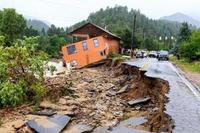-
Scrapping sea level protection puts Australian homes at risk
As the science on the coastal impacts of climate change gets stronger, the protections for Australia’s coastal communities are getting weaker. Along the eastern seaboard of Australia, where most Australians live, state governments are relaxing their policies and largely leaving it to local councils to decide if homes can be built in low-lying areas.Over the past fifty years, there have been twenty-five national inquiries and reports into coastal management. Those inquiries have overwhelmingly come to the conclusion that rather than leaving it to local councils, Australia needs one set of clear, national guidelines on coastal development and infrastructure. That is the opposite of what we are now seeing around Australia, with a mish-mash of different rules in different states. If that continues, everyone will pay.
-
-
Global map predicts giant earthquakes
Researchers have developed a new global map of subduction zones, illustrating which ones are predicted to be capable of generating giant earthquakes and which ones are not. The research comes nine years after the giant earthquake and tsunami in Sumatra in December 2004, which devastated the region and many other areas surrounding the Indian Ocean, and killed more than 200,000 people.
-
-
Cybersecurity isn’t all about doom and gloom
Much is made in the press of the devastating effects that weak cybersecurity is having on the economy in the United Kingdom and globally. The threat is compounded by a significant skills shortage. The U.K. government thinks the problem is so severe that it has identified cybersecurity as a Tier 1 national security threat and invested 860 million pounds to defend the country’s digital shores. What all this means is that there is money to be made from cybersecurity and small businesses should not fear it but embrace it. The business opportunities are boundless in cybersecurity. One area that is promising in this sense is the move towards smart cities. As the infrastructure around us, such as traffic lights and utilities becomes more regularly controlled via computers, market opportunities emerge
-
-
Zapping bridges with electricity to test for corrosion
One out of nine of the nation’s bridges is structurally deficient and that more than 30 percent of bridges have exceeded their 50-year design life; the average age of the nation’s bridges is currently forty-two years. Motorists in the United States make more than 200 million trips across bridges rated structurally deficient or in need of significant maintenance and yearly inspection. Of the more than 17,000 bridges in New York, 12.5 percent are structurally deficient and 27 percent are considered functionally obsolete. One major culprit for bridges’ deterioration: corrosion of reinforcing steel. New testing method could replace expensive, time-consuming visual inspections.
-
-
New Jersey shore to face unprecedented flooding by mid-century
Geoscientists estimate that the New Jersey shore will likely experience a sea-level rise of about 1.5 feet by 2050 and of about 3.5 feet by 2100 — 11 to 15 inches higher than the average for sea-level rise globally over the century. That would mean, the scientists say, that by the middle of the century, the one-in-ten year flood level at Atlantic City would exceed any flood known there from the observational record, including Superstorm Sandy.
-
-
Colorado faces costly, lengthy challenge fixing flood-damaged roads

The Colorado Department of Transportation(CDOT) has met the 1 December 2013 deadline to reopen twenty-seven flood-battered highways in the state, but the department still faces major challenges in making permanent fixes to damage caused by September’s historic floods. The scope of the task is currently being evaluated as highway managers explore technological and engineering changes needed to keep about 485 miles of damaged roadway more resistant to mass flooding.
-
-
No need to worry about getting fried by gamma ray burst

If recent news that University of Alabama in Huntsville (UAH) researchers observed the largest gamma ray burst ever has you nervous about getting blasted into extinction by a massive burst from space, the UAH researchers have good news. The chances of Earth being fried by a burst are exceedingly rare.
-
-
New Silicon Valley focus on cybersecurity
The last time Silicon Valley focused on cybersecurity was in the 1990s. That focus saw the emergence of two giants: McAfee and Symantec. The two companies remain the most recognizable household names, thanks to their traditional firewall and anti-virus products. Now they find the arena which they thought was their own encroached from two sides. On one side there are tech giants like Hewlett-Packard and Cisco Systems, which see new revenue opportunity in cybersecurity. On the other side there is a rush of start-ups backed by large investments of venture capital.
-
-
Cyberweapons to defend electricity's perimeter
Cyber war, cyber terror, and cyber crime target all manner of operations and, by design, cannot be detected until they have already done their damage. Nobody is immune to such attacks, and particularly target-rich environments include government bodies and critical power industries such as bulk electricity supply (BES). Hackers and cyberdefenders clash just outside of, at, or inside an organization’s electronic security perimeter (ESP). To counter such threats, a bulk electricity solution — North American Electric Reliability Corp.’s (NERC) Critical Infrastructure Protection (CIP) standards regarding BES cybersecurity — was launched in January 2008 through Federal Energy Regulatory Commission (FERC) oversight. How effective is the use of cyberweapons in protecting electricity’s perimeter?
-
-
NIST's cybersecurity framework for infrastructure
Company which are managing critical infrastructure in the United States and disregard the Preliminary Cybersecurity Framework, issued by the National Institute of Standards and Technology (NIST) in late October, do so at their own peril. The framework is now in its final comment stage and due to be released in mid-February. It lays out a set of comprehensive but voluntary cybersecurity practices.
-
-
EU issues new manual for defending ICS against cyberattacks
ENISA, the EU’s cybersecurity agency, has issued a new manual for better mitigating attacks on Industrial Control Systems (ICS). ICS support vital industrial processes primarily in the area of critical information infrastructure such as the energy and chemical transportation industries, where sufficient knowledge is often lacking. As ICS are now often connected to Internet platforms, additional security preparations must be taken. ENISA says that the new guide provides the necessary key considerations for a team charged with ICS Computer Emergency Response Capabilities (ICS-CERC).
-
-
Federal IT spending to exceed $11 billion by 2018
A new report from Delteks, contracted spending on cybersecurity will continue to grow from nearly $9 billion in FY2013 to $11.4 billion in FY2018, driven by multiple initiatives aimed at improving the overall cybersecurity posture of federal agencies. Persistent threats, complex and evolving policy issues, and changing technologies highlight ongoing cyber-workforce shortages to drive investments despite constrained federal IT funding.
-
-
Cybersecurity Manhattan Project needed
On a daily basis, cyberattacks successfully steal U.S. intellectual property and military weapons plans, disrupt banking systems operations, and gain access to personal information which is supposed to be secure. The question: What it will take to harness America’s resources to push the country into developing effective national cyberdefense capabilities? Should it take another 9/11? Experts say that the whole must be greater than the sum of its parts. Power grid cyberattack exercises, increased cyberwarrior staffing at U.S. Cybercom, and the authorization of preemptive cyberattacks by Presidential Policy Directive 20 are individually good steps. But where is the whole? The unifying call to action? The United States may not be able to have another Manhattan Project, but it should be able to develop a Manhattan Project mentality, one which is orchestrated and executed by the U.S. cybersecurity czar or perhaps the DHS.
-
-
Cyber Gym in Israel trains cyber-defenders
A group of IT and infrastructure companies in Israel have teamed up to launch Cyber Gym.The facility, inaugurated this month by Israel Electric Corp. (IEC), will train participants to defend against cyber attacks.When Sivan Shalom, Israel’s Infrastructure and Energy Minister, was asked whether Israel was more concerned about a physical or a virtual attack, he said: “I think the future battle will be in cyberspace.”
-
-
Sea-level rise to drive flooding regardless of changes in hurricane activity
Clamor about whether climate change will cause increasingly destructive tropical storms may be overshadowing a more unrelenting threat to coastal property — sea-level rise — according to a team of researchers. Since 1970, more than 60 percent of all economic losses — about $400 billion — occurred in the North Atlantic, even though it is one of the least active basins for hurricanes.The scientists say accelerated sea-level rise certainly will increase the flooding and property damage triggered by tropical cyclones — commonly known as hurricanes in the Atlantic and Northern Pacific — but predicting where, how often, and how powerful these storms will be when they make landfall is full of uncertainty.
-
More headlines
The long view
Helping Strengthen America’s Critical Infrastructure
Everyday life depends on a robust infrastructure network that provides access to running water, communications technology and electricity, among other basic necessities. The experts who keep our national infrastructure secure and resilient also need a strong network to share their knowledge and train the next generation of professionals capable of solving complex infrastructure challenges.
AI and the Future of the U.S. Electric Grid
Despite its age, the U.S. electric grid remains one of the great workhorses of modern life. Whether it can maintain that performance over the next few years may determine how well the U.S. competes in an AI-driven world.
Using Liquid Air for Grid-Scale Energy Storage
New research finds liquid air energy storage could be the lowest-cost option for ensuring a continuous power supply on a future grid dominated by carbon-free but intermittent sources of electricity.
Enhanced Geothermal Systems: A Promising Source of Round-the-Clock Energy
With its capacity to provide 24/7 power, many are warming up to the prospect of geothermal energy. Scientists are currently working to advance human-made reservoirs in Earth’s deep subsurface to stimulate the activity that exists within natural geothermal systems.
Experts Discuss Geothermal Potential
Geothermal energy harnesses the heat from within Earth—the term comes from the Greek words geo (earth) and therme (heat). It is an energy source that has the potential to power all our energy needs for billions of years.
